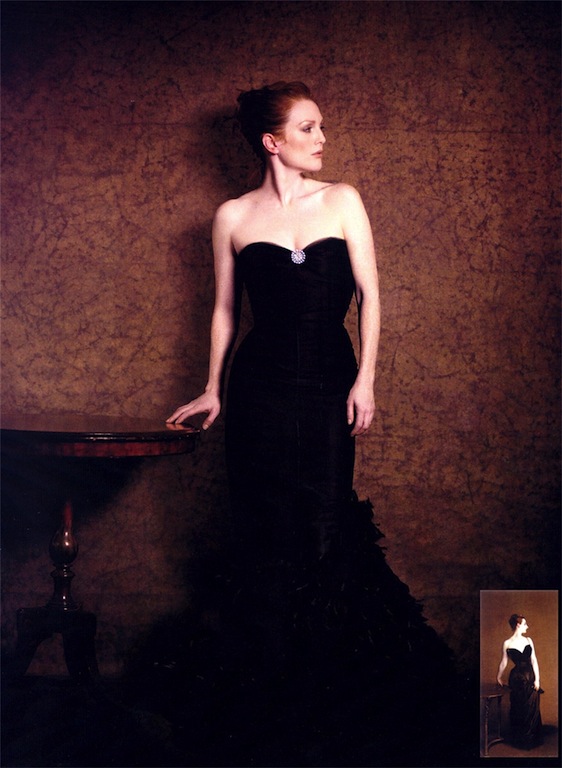 John Singer Sargent in his studio with his painting Portrait of Madame X, photographer unknown, 1884
John Singer Sargent in his studio with his painting Portrait of Madame X, photographer unknown, 1884
 Madame X or Portrait of Madame X, John Singer Sargent, 1884
Madame X or Portrait of Madame X, John Singer Sargent, 1884
Madame X or Portrait of Madame X is the informal title of a portrait painting by John Singer Sargent of a young socialite named Virginie Amélie Avegno Gautreau, wife of Pierre Gautreau. The model was an American expatriate who married a French banker, and became notorious in Parisian high society for her beauty and rumored infidelities. She wore lavender powder and prided herself on her appearance.
Madame X was painted not as a commission, but at the request of Sargent. It is a study in opposition. Sargent shows a woman posing in a black satin dress with jeweled straps, a dress that reveals and hides at the same time. The portrait is characterized by the pale flesh tone of the subject contrasted against a dark colored dress and background.
For Sargent, the scandal resulting from the painting’s controversial reception at the Paris Salon of 1884 amounted to the failure of a strategy to build a long-term career as a portrait painter in France, though it may have helped him establish a successful career in Britain and America.
Renowned for her beauty, Gautreau represented the parisienne, a new type of Frenchwoman recognized for her sophistication. The English-language term “professional beauty”, referring to a woman who uses personal skills to advance to elite status, was also used to describe her. Her unconventional beauty made her an object of fascination for artists; the American painter Edward Simmons claimed that he “could not stop stalking her as one does a deer.” Sargent was also impressed, and anticipated that a portrait of Gautreau would garner much attention at the upcoming Paris Salon, and increase interest in portrait commissions. He wrote to a friend:
“I have a great desire to paint her portrait and have reason to think she would allow it and is waiting for someone to propose this homage to her beauty. If you are ‘bien avec elle’ and will see her in Paris, you might tell her I am a man of prodigious talent.”
Although she had refused numerous similar requests from artists, Gautreau accepted Sargent’s offer in February 1883.Sargent was an expatriate like Gautreau, and their collaboration has been interpreted as motivated by a shared desire to attain high status in French society.
A figure study of Madame Gautreau in watercolor and graphite, John Singer Sargent, circa 1883
Little progress was made during the winter of 1883, as Gautreau was distracted by social engagements, and was not by nature inclined to the discipline of sitting for a portrait. At her suggestion, Sargent traveled to her estate in Brittany in June, where he commenced a series of preparatory works in pencil, watercolors, and oils. About thirty drawings resulted from these sessions, in which many poses were attempted.
Gautreau was bored by the process of sitting; here, too, there were social engagements, as well as the responsibilities of tending to her four-year-old daughter, her mother, house guests, and a full domestic staff. Sargent complained of “the unpaintable beauty and hopeless laziness of Madame Gautreau.”
 Nicole in Oscar de la Renta photographed by Steven Meisel, 1999
Nicole in Oscar de la Renta photographed by Steven Meisel, 1999
Julianne Moore photographed by Peter Lindbergh, 2008
For Spring 2008 Christian Dior Haute couture collection, John Galliano’s primrose path of inspiration had, he said, wended its way from John Singer Sargent’s Madame X through to the gilded swirls and bejeweled geometrics of Gustav Klimt.



